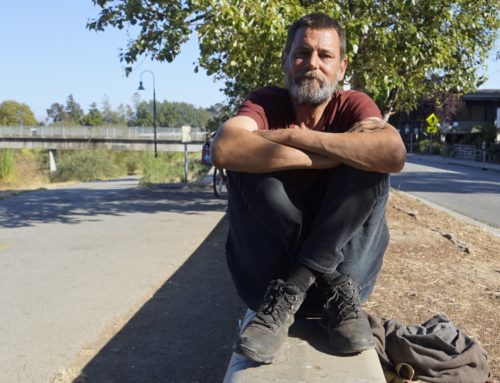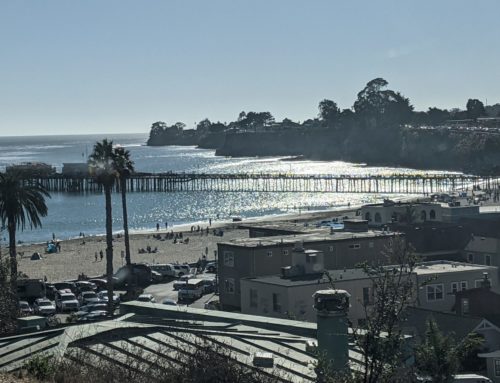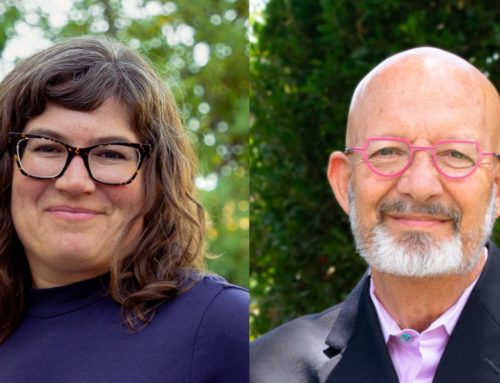Were some COVID-19 deaths preventable in Santa Cruz County long-term care facilities? This episode investigates why some senior homes — which had more than half of the COVID deaths in the county — waited for vaccines through January while others received vaccines. Separately, the episode includes a conversation with contributing reporter Jerimiah Oetting and Santa Cruz Local’s Kara Meyberg Guzman and Stephen Baxter about whether new housing means more water demand in Santa Cruz County. Transcript below.
Read the stories:
- Vaccines came slowly for the most vulnerable in Santa Cruz County (March 3, 2021)
- Does more housing mean more water demand in Santa Cruz County? (Feb. 15, 2021)
Transcript
Advertisement: Investing doesn’t have to be complicated. Talk to the experienced professionals at WI Investment Advisory Group. Visit them at 1535 Seabright Ave., Suite 110 in Santa Cruz. They are Registered Representatives and Investment Adviser Representatives with, and offer securities and advisory services through, Commonwealth Financial Network, Member FINRA/SIPC, a Registered Investment Adviser. WI Investment Advisory Group, Investing for What’s Important. wiiag.com
MUSIC
STEPHEN BAXTER: I’m Stephen Baxter. This is Santa Cruz Local. I want to talk about two recent, in-depth stories that appeared on our website at SantaCruzLocal.org. The first story is about the slow vaccine rollout for seniors in long-term care facilities in Santa Cruz County this winter. Were some coronavirus deaths preventable at nursing homes in the county? The second story is about water demand. It answers the question, does new housing mean more water demand in Santa Cruz County? I want to take both stories off the page and bring them to life.
We’ll talk to Jerimiah Oetting, who did much of the reporting for the stories.
And first, we’re here with Kara Meyberg Guzman, our CEO and co-founder. Kara, you did some of the reporting and you helped edit the stories with me. For this first story, ‘Vaccines came slowly for the most vulnerable in Santa Cruz County,’ tell us about where this story came from.
KARA MEYBERG GUZMAN: Yeah, this actually came from a conversation I had with Marm Kilpatrick. He’s a professor at UC Santa Cruz. And he mentioned that he didn’t think enough attention was being paid to the slow rollout of vaccines in nursing homes.
MARM KILPATRICK: If you want to go down this rabbit hole — which is a little bit, I think, depressing, but real — I’m 99% sure that we were vaccinating healthcare workers two weeks before the first nursing home resident in Santa Cruz County got vaccinated. And so so that means that even though those are theoretically both equally high tier people to vaccinate, and even though one can make a very strong argument that the people most likely to die, weren’t the health care workers, but in fact, were the nursing home residents that did not result in them getting the vaccines first. I’m not trying to point fingers, I’m trying to suggest that this is a challenging issue. And there were big trade offs to be made.
KMG: When the vaccines came to Santa Cruz County in December, our healthcare leaders kept saying over and over in these press conferences, that equity was a major goal of the vaccine rollout and that they would try to get vaccines out to the most vulnerable first, we’ve seen the most vulnerable have been people in nursing homes. That’s where, you know, more than half of COVID deaths have come from in our county and our state. We needed help calling all the nursing homes and all the people all the vaccine providers, and that’s where Jerimiah came in.
SB: Right. So we handed this to you, Jerimiah, there were 183 deaths related to COVID. In the county. More than half of those were in long term care facilities. So Jerimiah, you called those 20 facilities that had had COVID deaths, and about half responded. Can you describe what the atmosphere was like as they waited for the vaccine?
JERIMIAH OETTING: A lot of the administrators at long term care facilities, in particular, the ones that got their vaccine, pretty late, as late as early February, really expressed a lot of frustration about the rollout. They said they were waiting in the dark, checking their email repeatedly even checking their spam folders to see if their notification that they’d be getting the vaccine soon had gone into their spam folder. Right. A lot of them spoke about their residents who had been in isolation for a lot of this pandemic, unable to see friends or loved ones. And they were waiting for the vaccine as a ticket out of that isolation. They told me stories about residents who had really declined in at least mental health, but also physical health over the course of the pandemic, and how the extra month of waiting really set them back even further.
SB: Can you walk us through the timeline of the vaccine rollout?
JO: So in October of 2020, before the vaccines were even available for anyone, federal authorities announced the Federal Pharmacy Partnership for Long-Term Care Program as a way to fast track the vaccine to these long term care clinics that houses the most vulnerable people in a congregate living situation where it’s really easy to contract COVID and December 13, after they announced that program, the SEC, the Secretary of us Health and Human Services, Alex Azar was quoted as saying we could have every nursing home patient vaccinated in the US by Christmas. But in Santa Cruz County, that didn’t happen on December 16, the first vaccine doses went to healthcare workers. Then Christmas passed, and nobody in these long term care facilities had received their first doses. The first doses at nursing homes happened in Santa Cruz County on December 29. at Santa Cruz post acute. We pieced together a timeline that you can find in the story of when the other facilities I spoke with received their first doses. But But the first assisted living facilities didn’t receive their first doses until January 11. According to representatives from the pharmacies that were part of the federal program that I spoke to, they weren’t allowed to begin distributing to nursing homes and other long term care facilities until different different dates for skilled nursing facilities. The pharmacy spokesperson said they were able to begin distributing the vaccine on December 28. And then for assisted living facilities not until January 11. So that already created a big gap in the experience that these long term care facilities had with the federal program.
SB: And Kara, you talked to Gail Newel about the slow rollout and what was the impression you got from her?
KMG: So I talked to Dr. Gail Newel, she’s Santa Cruz County’s health officer. Yeah, why don’t we just let listen to what she had to say?
GAIL NEWEL: The slow rollout of the federal pharmacy partnership probably, you know, some of the most recent deaths may have been prevented by by a quicker rollout, it would be a handful of deaths. But of course, every life is important, every death is important. So, you know, if that program would have happened more quickly, more efficiently, then perhaps some of those could have been avoided.
The federal government is a big, unwieldy entity, and it takes them a long time to get programs going. And so, my understanding is, is that by the time the contracts were done with CVS and Walgreens, then CVS and Walgreens still had to hire the workforce to go out and do the vaccinations and go out into the nursing homes and other long-term care facilities. And so it took a while to onboard personnel to actually go out and give the vaccines.
These decisions are all really difficult. And, you know, we’re always weighing the risks and benefits of each. You know, and if we had given away 3,000 or so of our vaccines for the community, that would have meant 3,000 75-plusers that wouldn’t have gotten their vaccine. So, you know, there may have been deaths in that group as well.
By the time vaccines came to us, we, the nursing homes had all had significant outbreaks already and So we knew that at least for the next 90 days, most of the residents had immunity already. And so the vast majority of the nursing home residents and all of the nursing homes were already infected and had immunity that we knew would last for 90 days.
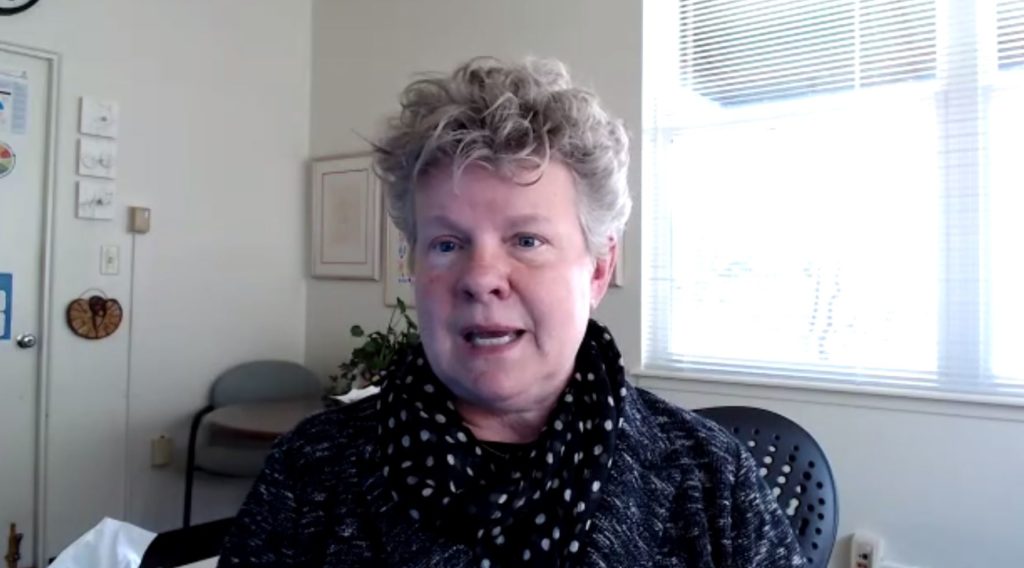
Dr. Gail Newel is Santa Cruz County’s health officer. (Zoom screenshot)
KMG: It was pretty apparent that the federal pharmacy program was rolling out vaccine slower than expected. And there was a point when our county health leaders faced a decision. It was, do we give some of our limited vaccine supply to these long-term care facilities? I talked to Dr. Gail Newel, and Dr. David Ghilarducci about this. They lead our county’s pandemic response.
And they ended up deciding not to give any of the county’s vaccine supply to these long-term care facilities, in part because they said the state wouldn’t reimburse the county for doing that.
The problem with the vaccine rollout in California is that there hasn’t been one central distributor of the vaccine. And as a result, there’s been sort of this uneven rollout. For example, in Santa Cruz County, until recently, the lion’s share of the vaccine has been administered by Sutter Health. From what I see happening is that decision makers have been trying to balance equity and efficiency with the vaccine rollout. I mean, sure, it makes a lot of sense to give a lot of the vaccine supply to these large hospital systems like Sutter Health, Dignity Health, Dominican, you know. They’re equipped, they have the staffing to administer the vaccine, and it’s going to be a lot quicker.
The problem is the people who are most vulnerable, the people who are most at risk of getting seriously sick aren’t necessarily patients of Sutter Health, Dominican and Dignity. It’s really, you know, Latinos, especially South County Latinos. And most vulnerable, arguably are those patients have long term care facilities. And these groups are a lot harder to reach. For example, Dr. Ghilarducci told me that the county could have given vaccine to these long-term care facilities, but it’s not like they could just give them a shipment of vaccine. Ghilarducci told me that they would have had to assemble a mobile strike team of staff to administer the vaccine, because you know, they have this 30-minute observation window after patients receive the shot, just to make sure that there’s no severe allergic reactions.
So the county tracks the number of reported COVID deaths on its COVID dashboard website, including the number of deaths at long term care facilities. And so every Thursday, I’ve been taking a screenshot of the COVID death dashboard. It’s a little bit complicated because it can sometimes take up to two or three weeks between the date of death and when it’s reported and recorded as a COVID death.
So while we don’t have an exact finger on which nursing home and long term care facility deaths occurred when what we do know is that from January 26 to February 28, there were 11 COVID deaths reported at long-term care facilities in Santa Cruz County. It’s not someone who’s necessarily COVID positive when they die. Dr. Gail Newel explained it once, you know, if you get hit by a bus, while you happen to be COVID positive, you wouldn’t be counted as a COVID death. It would, COVID would have had to been a contributing factor to that death for it to be on this list.
JO: One of the long-term care facilities I spoke with that had to wait the longest for their first dose was Valley Haven in live oak. They received their first dose on Feb. 4, which is the same day that Sutter Health started vaccinating its patients that were 65 and older in the general population.
One thing that really surprised me speaking with all these administrators at nursing homes and assisted living facilities, is just how exhausted they sounded and how describing this process. It sounds like they were frustrated, but now that they are vaccinated, there’s this sense of relief. For them it’s not a numbers game. These are their residents and people that they work work with and their families. And so hearing them describe this waiting game between when they were told they might expect to get the vaccine and when they actually got it sounded frustrating. And this federal program happened across the state and the experience that we had here in Santa Cruz County might be similar to other counties.
SB: The second story I want to talk about was from February. And the title of it was, ‘Does more housing mean more water demand in Santa Cruz County?’ And Kara, this story came from a Santa Cruz Local member. Can you talk about that?
KMG: Yeah, I got an email from Nancy Drinkard, who’s a Santa Cruz Local member. She wrote to me after I wrote a story about where housing will go in Santa Cruz. And she wrote, “Do we have a sufficient, sustainable water supply to support new housing at the densities proposed?”
This is a constant theme we hear when we attend meetings about housing proposals. Residents are always asking, you know, where’s the water to meet the demand here? I actually got a text from my mother-in-law, Nancy Meyberg, also a Santa Cruz Local member asking essentially the same thing. Nobody talks about water demand of these housing proposals, and she wanted to know more.
SB: And this one was interesting for me. And as a bit of background, we had just got done with a story on UC Santa Cruz’s Long Range Development Plan. And in that the city of Santa Cruz had weighed in on what would the potential water demand be, if the campus were to expand, there’d be 1000s more students, faculty and staff, more housing, etc. And to my surprise, the city had essentially said in their water report, that the demand would be negligible, one, I mean, in a difference to today and two, they said that of the growth that had happened at UC Santa Cruz’s campus, in the last roughly 15 years, water demand had basically remained flat. And that was really surprising to me.
And so judging by that, plus Nancy Drinkard’s excellent email, I thought, Well, what does this look like for the rest of the county? And so we set out to inform the discussion. And just to be clear, we weren’t trying to prove anything. We just wanted to know what the situation was, if you’re trying to answer this question, what is going to be the water demand with new housing in the county? How do you go about attacking that as a reporter, Jerimiah?
JO: Yes, Stephen. I think you and I both started this story thinking I would be looking at what these housing goals were and how much housing was going to happen in the county and how much water that housing was going to require. When I started speaking with water district managers across the county, the story actually went in a different direction.
It turns out, housing isn’t really the issue they’re most concerned with. They said the amount of water that would be required to, they said the amount of water that would be required by new housing developments was a drop in the bucket compared to the other water supply issues that exist already. The water implications of the county’s forecasted growth are really minor compared to the much larger systemic issues of securing our water supply. And that’s what the water district managers that I spoke with are focused on. And they all said across the board that if there are more residents of Santa Cruz County, that’s manageable, that more residents in Santa Cruz County is something manageable that they can plan for as long as they solve these other water security issues.
SB: Just one thing I want to ask you about Jerimiah, that through your reporting, this great chart came out that showed water connections in the county going up over time, and yet water demand falling over time. So was that part of the conclusion that they had come to?
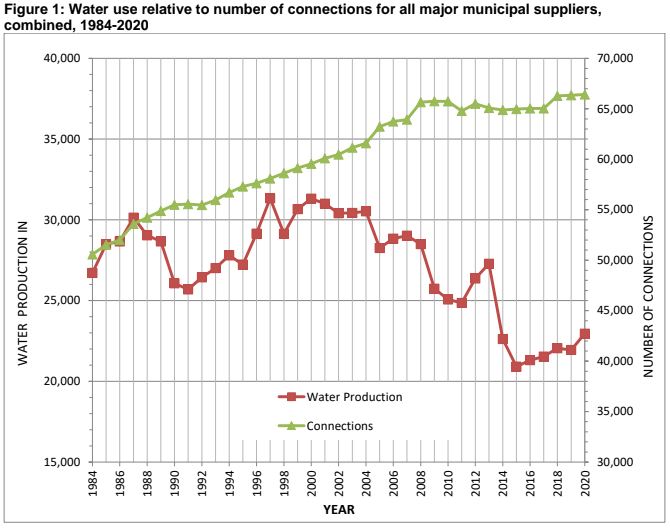
Santa Cruz County data shows decreased water use despite more water connections to customers. (County of Santa Cruz)
JO: Yeah, exactly. In the last couple of decades, despite water connections increasing, the water demand seems to be dropping. And there’s a number of reasons for that. One of them is new technology, basically high efficiency plumbing. And another is conservation efforts by the people of Santa Cruz County who, in the face of a multi-year drought in the mid 2010s, decided to use less water overall. And even though we came out of that drought, water use hasn’t significantly gone up. A lot of the housing that’s going to be built in Santa Cruz County over the coming decades is going to be dense multifamily housing and the water cost (demand) per person is really low compared to a single family home that has landscaping needs and that and those larger water requirements.
SB: What I kind of like about this story is that it seems, it kind can be weaponized by both sides. In other words, the people who are very pro housing in the county can look at it and say one thing, and then the people who are against growth in housing can can say another, if no more homes were built from today forward, you’d still have all these structural problems that you’d still have to fix. Those don’t go away. If I’m against new housing, against growth, I could say, ‘Well see, we’ve got all these water problems that we can’t solve, you know, that’s not going to help. But if I’m a housing advocate, I can say that, well demand’s not going to go up as based on previous history, especially if you build in smart ways. So it’s just that the reality seems a little more complicated than than you might have thought.
JO: Yeah, yeah. The water issues that Santa Cruz County has right now need to get dealt with, even if nobody came here, but they don’t have the ability, but nobody in the county has the authority to prevent people from moving here. And so it becomes more of an issue of securing supply than an issue of how many people might move here. I can’t remember who said it, but water district managers told me that even if the maximum number of people forecasted to move to Santa Cruz actually moved here, the water supply, the water demand increase would be manageable as long as they can solve these more systemic water supply security issues.
SB: We will link to both of these stories in our show notes and I encourage you to read them and and check out Jerimiah Oetting’s reporting.
JO: Thanks. Yeah.
MUSIC
SB: Santa Cruz local offers its news stories for free as a public service. We want all Santa Cruz County residents to have access to fair and accurate local news. We’re supported by people like you who chip in $9 a month or $99 a year. We call them our members. Will you join today? Join us at Santa CruzLocal.org/membership. The link is that our show notes.
Thank you especially to our highest-level members:
- Elizabeth and David Doolin
- Fran Goodwin
- Debra Szeicei
- Chris Neklason
- Patrick Reilly
- Elena Cohen and Steve Ritz
Stephen Baxter is a co-founder and editor of Santa Cruz Local. He covers Santa Cruz County government.


